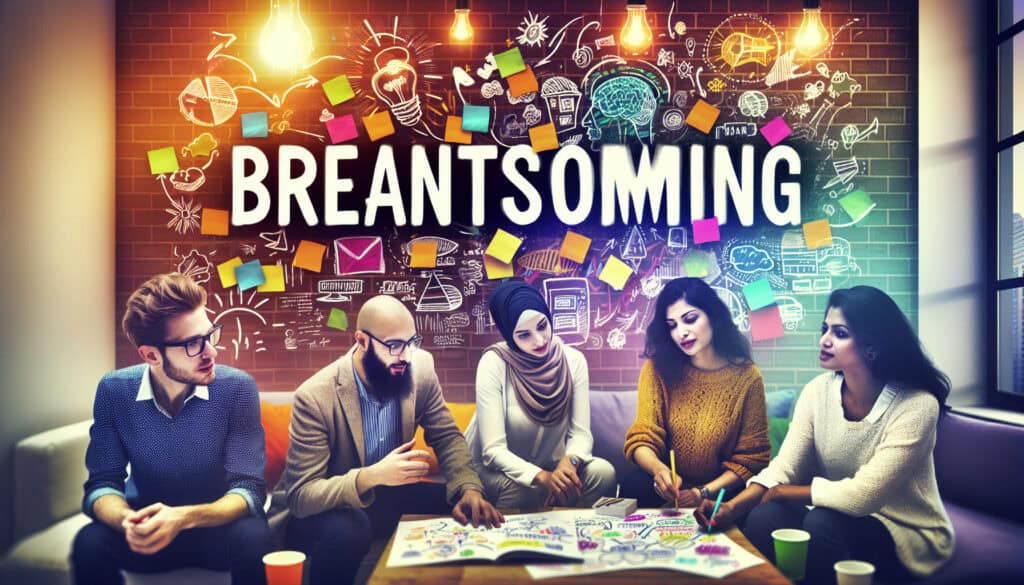A group creativity technique by which efforts are made to find a conclusion for a specific problem by gathering a list of ideas spontaneously contributed by its members.
- Metodologías: Clientes y marketing, Economía
Lluvia de ideas

Lluvia de ideas
- Metodología ágil, Lluvia de ideas, Creatividad, Colaboración multifuncional, Pensamiento de diseño, Ideación, Innovación, Técnicas de resolución de problemas, Trabajo en equipo
Objetivo:
Cómo se utiliza:
- Brainstorming sessions are typically unstructured and informal, and participants are encouraged to generate as many ideas as possible, without criticism or judgment.
Ventajas
- Can be a fun and engaging way to generate ideas, can lead to a large number of ideas in a short amount of time, and can be used to solve a wide range of problems.
Contras
- Can be dominated by a few vocal participants, can lead to a lot of ideas that are not relevant or feasible, and may not be suitable for all types of problems.
Categorías:
- Ideación, Resolución de problemas
Ideal para:
- Generating a large number of ideas for a specific problem.
Brainstorming is widely utilized in various phases of product design, particularly during the ideation stage, where designers, engineers, and marketing teams collaborate to explore creative solutions for a given challenge. This informal approach thrives in industries such as technology, consumer products, automotive, and healthcare, where innovation is paramount for staying competitive. Typically, the initiative for a brainstorming session can be driven by project managers, design leads, or innovation officers, and often includes diverse participants like engineers, designers, researchers, and even customers to encourage a wide range of perspectives and expertise. Techniques such as mind mapping, round-robin sharing, or the ‘6-3-5’ method—where six participants generate three ideas each within five minutes—can further enhance idea generation. Brainstorming also allows for the rapid fusion of existing concepts into new products. The absence of judgment during sessions encourages bold thinking, which can be particularly beneficial when addressing complex desafíos de diseño or exploring novel technologies. Teams can document findings and prioritize ideas for further development or prototyping, supporting the iterative design process common in engineering and product development. Successful applications include everything from creating user-centered digital applications to innovating sustainable materials in manufacturing, demonstrating its versatilidad across various fields.
Pasos clave de esta metodología
- Set a clear objective or problem statement for the session.
- Encourage unfiltered idea generation; all ideas should be voiced regardless of feasibility.
- Build on each other’s ideas; connect and elaborate on initial suggestions.
- Ensure equal participation from all members, encouraging quieter individuals to share.
- Utilize visual aids, such as sketches or mind maps, to represent ideas dynamically.
- Introduce prompts or stimuli to spark creative thinking when ideas stall.
- Keep the energy up; encourage enthusiasm and creativity throughout the session.
- Allow for spontaneous ideas and tangents that may lead to valuable insights.
Consejos profesionales
- Incorporate techniques like Round Robin and Brainwriting to ensure equal participation and prevent dominant voices from overshadowing quieter team members.
- Set specific time constraints for idea generation phases followed by relaxation periods to stimulate divergent thinking and avoid cognitive fatigue.
- Document all ideas visually using tools like mind maps or digital boards, fostering a collaborative atmosphere and enabling building upon others' contributions.
Leer y comparar varias metodologías, recomendamos el
> Amplio repositorio de metodologías <
junto con otras más de 400 metodologías.
Sus comentarios sobre esta metodología o información adicional son bienvenidos en la dirección sección de comentarios ↓ , así como cualquier idea o enlace relacionado con la ingeniería.
Contexto histórico
1949
1950
1950
1960
1960
1960
1960
1940
1950
1950
1958
1960
1960
1960
1960
(si se desconoce la fecha o no es relevante, por ejemplo "mecánica de fluidos", se ofrece una estimación redondeada de su notable aparición)















Publicaciones relacionadas
Calculadora de METS a calorías
Metaanálisis
Asignación de mensajes
Diagramas de modelos mentales
Fuerzas de empuje y tracción máximas admisibles
Planificación de necesidades de material (MRP)